Samsonite International Bundle
Can Samsonite Conquer the Future of Travel?
From its roots in 1910 Denver, Colorado, Samsonite International has transformed from a trunk maker to a global luggage giant, boasting a 20% market share as of 2023. With a diverse portfolio including Tumi and American Tourister, the company, now known as Samsonite Group S.A. since January 2025, has consistently adapted to the evolving travel goods market. Its journey is a testament to the power of strategic acquisitions and innovative product launches.
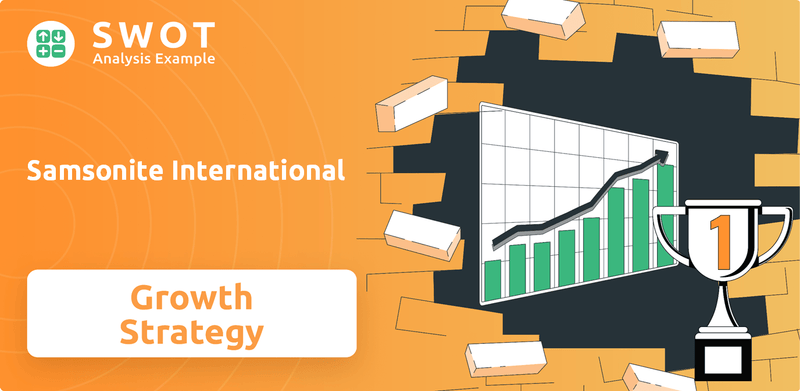
This analysis delves into the Samsonite International SWOT Analysis to explore the company's ambitious Samsonite growth strategy and the promising Samsonite future prospects. We'll examine its strategic moves, including brand expansion strategy, and the impact of the luggage industry analysis on its financial performance review, providing insights into its long-term investment strategy within the competitive landscape of the travel goods market. Understanding Samsonite's international expansion plans and e-commerce strategy is crucial for investors and strategists alike, as we assess its potential for sustainable business practices and emerging market opportunities.
How Is Samsonite International Expanding Its Reach?
The company, is actively pursuing several expansion initiatives to drive future growth, focusing on both geographical reach and product diversification. This approach is central to its Samsonite growth strategy, aiming to strengthen its position in the travel goods market.
A key component of this strategy involves deepening market penetration in both established and emerging markets. The company is particularly focused on direct-to-consumer (DTC) channels to enhance customer engagement and control over the brand experience. This strategic move is crucial for long-term success in the luggage industry analysis.
In 2024, the company added a net of 67 company-operated retail stores, bringing its global retail network to 1,119 stores by December 31, 2024. This expansion of its physical footprint is complemented by significant investments in e-commerce, which saw a 5.8% year-over-year growth in 2024, reaching $411.1 million in sales. Latin America and Europe experienced double-digit e-commerce growth at 55% and 12.6% respectively, with Asia and North America also showing steady increases. This growth highlights the effectiveness of its Samsonite e-commerce strategy.
The company is actively expanding its retail presence. In 2024, it added a net of 67 company-operated retail stores. This brings the total number of stores to 1,119 globally by the end of 2024. This expansion supports its Samsonite international expansion plans.
E-commerce is a significant growth area for the company. In 2024, e-commerce sales grew by 5.8% year-over-year. The total e-commerce sales reached $411.1 million. This highlights the importance of the company's brand expansion strategy.
The company is focusing on both established and emerging markets. Latin America and Europe saw significant e-commerce growth. Asia and North America also showed steady increases in e-commerce sales. This is a key element of its Samsonite future prospects.
The company is diversifying its product offerings. This includes introducing new products and expanding its non-travel product categories. This strategy aims to access new customer segments and diversify revenue streams. This supports its Samsonite product innovation strategy.
The company also plans to introduce new products and open new stores for its Tumi and American Tourister brands. While global travel is expected to see steady growth in 2025, supporting long-term business expansion, the company is also diversifying its net sales mix towards non-travel product categories, which are seen as offering strong long-term growth opportunities. This strategic shift aims to access new customer segments and diversify revenue streams, staying ahead of industry changes. The company is also exploring a potential dual listing of its securities in the United States to enhance liquidity and shareholder accessibility. For a deeper dive into the company's performance, consider reading an analysis of the company's financial health.
The company's expansion initiatives focus on both geographical and product diversification to drive growth. These initiatives include expanding retail presence, growing e-commerce sales, and introducing new products.
- Deepening market penetration in established and emerging markets.
- Investing in e-commerce to enhance customer reach.
- Introducing new products and expanding non-travel categories.
- Exploring a potential dual listing in the United States.
Samsonite International SWOT Analysis
- Complete SWOT Breakdown
- Fully Customizable
- Editable in Excel & Word
- Professional Formatting
- Investor-Ready Format
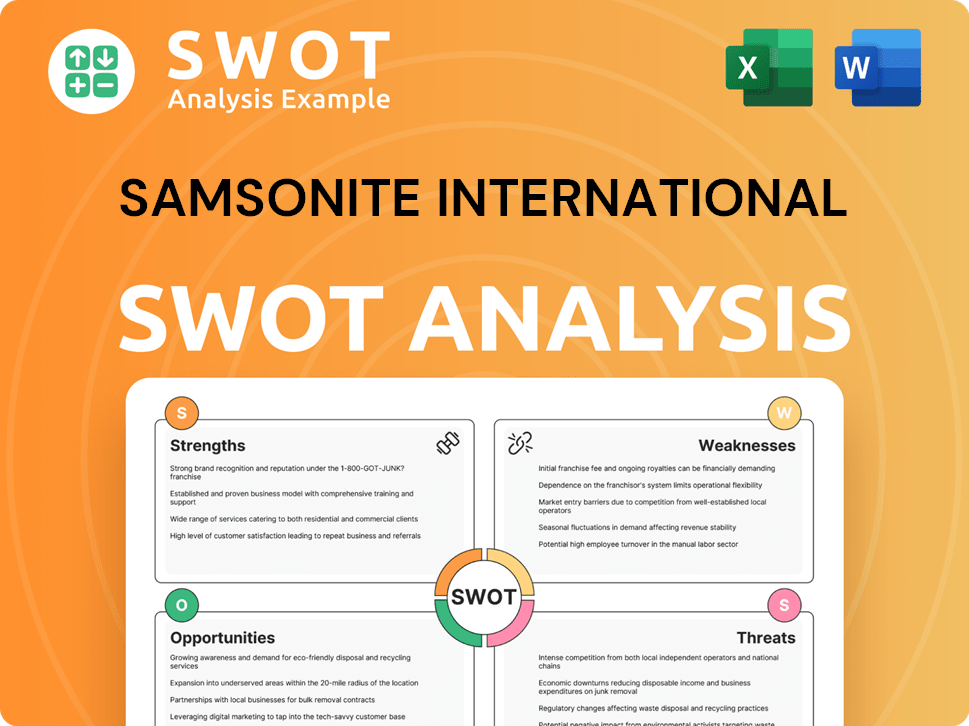
How Does Samsonite International Invest in Innovation?
The innovation and technology strategy of Samsonite International is a key driver for its sustained growth. The company focuses on continuous product development and digital transformation to adapt to the evolving travel industry. This approach is crucial for maintaining a competitive edge in the luggage industry analysis and travel goods market.
A significant aspect of the company's strategy involves integrating advanced technology into its products. While specific R&D investments for 2024 were not detailed separately, the company's ongoing product launches demonstrate a commitment to innovation. This focus helps the company stay ahead in a competitive landscape, ensuring its relevance in the market.
The company's commitment to sustainability is a core element of its innovation strategy. This involves ambitious goals to reduce environmental impact and promote eco-friendly practices. This approach is essential for long-term success and aligns with consumer preferences for sustainable products. To learn more about the company's origins, you can read a Brief History of Samsonite International.
By 2025, the company aims for 100% of its products to be made from recycled materials. This demonstrates a strong commitment to environmental responsibility and sustainable business practices.
In 2023, products featuring recycled content accounted for 34% of net sales, a significant increase from 23% in 2022. This growth reflects the company's progress in integrating sustainable materials.
In 2023, the company achieved 100% renewable electricity across its global operations, two years ahead of its 2025 target. This initiative significantly reduces the carbon footprint of its operations.
The company reduced the carbon intensity of its operations by 85% compared to a 2017 baseline. This demonstrates a substantial impact on reducing its environmental footprint.
The company has a science-based climate target to reduce Scope 3 emissions from purchased goods and services by 52% per unit of gross profit by 2030, compared to a 2022 baseline. This target, validated by the SBTi in March 2025, underscores its commitment to climate action.
The introduction of the ESSENS Limited Edition in 2024, made with at least 35% pre-owned recycled suitcases, showcases the company's move towards circular design and sustainable product innovation strategy.
The company's focus on sustainability and technological integration is evident in its product development and operational practices. These initiatives support the company's long-term investment strategy and brand expansion strategy.
- Emphasis on recycled materials in product manufacturing.
- Transition to renewable energy sources across global operations.
- Setting and achieving science-based climate targets.
- Introduction of circular design through limited-edition products.
Samsonite International PESTLE Analysis
- Covers All 6 PESTLE Categories
- No Research Needed – Save Hours of Work
- Built by Experts, Trusted by Consultants
- Instant Download, Ready to Use
- 100% Editable, Fully Customizable
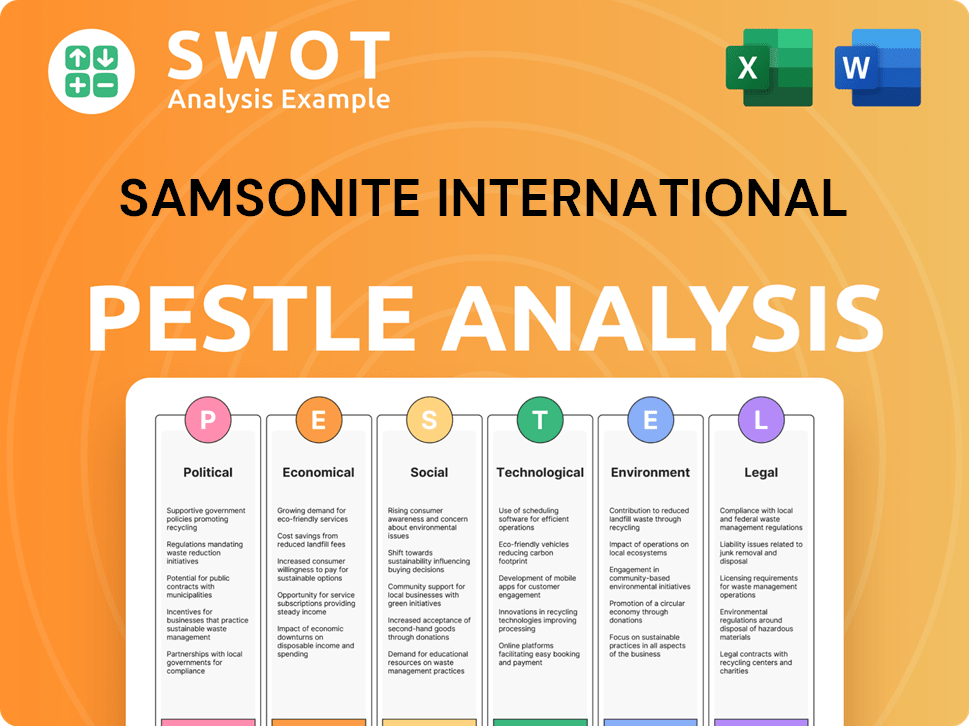
What Is Samsonite International’s Growth Forecast?
The financial landscape for the company presents a mixed picture, with recent performance indicating both challenges and opportunities. The company's ability to navigate these dynamics will be critical to its future success. A deeper dive into the financial data reveals key trends and strategic initiatives.
For the year ended December 31, 2024, consolidated net sales were US$3,588.6 million, reflecting a 2.5% decrease compared to 2023. However, on a constant currency basis, sales were approximately flat. The gross profit margin improved, reaching 60.0% in 2024, up from the previous year. The adjusted EBITDA margin was 19.0% for the same period.
Looking at the first quarter of 2025, net sales were US$796.6 million, a 7.3% decrease (4.5% on a constant currency basis) compared to Q1 2024. The gross profit margin for Q1 2025 was 59.4%, slightly down from 60.4% in Q1 2024. The adjusted EBITDA margin for Q1 2025 decreased to 16.0% from 18.8% in Q1 2024.
The company's sales performance in 2024 showed a slight decline, but remained stable when adjusted for currency fluctuations. The first quarter of 2025 saw a decrease in net sales, indicating ongoing challenges. The Target Market of Samsonite International is a key factor in understanding sales trends.
Gross profit margin increased in 2024, indicating improved efficiency. However, the Q1 2025 gross profit margin saw a slight decrease. Adjusted EBITDA margins also experienced a dip in the first quarter of 2025.
The company anticipates improved constant currency net sales growth throughout 2025. It expects a low to mid-single-digit decline in Q1 2025 compared to Q1 2024. The company is focused on higher-margin brands, channels, and regions.
The company aims to maintain strong adjusted free cash flow generation. In 2024, adjusted free cash flow was US$311.0 million. The company plans to invest in organic growth, return cash to shareholders, and deleverage its balance sheet.
In 2024, the company returned US$307.6 million to shareholders. This was achieved through share buybacks of US$157.6 million and a cash distribution of US$150.0 million. This demonstrates the company's commitment to shareholder value.
Analyst forecasts for the company in 2025 project significant potential growth. The average price for SMSOF is estimated at $9.8519, with a high of $11.79 and a low of $7.91. For SMSEY, the average price is projected at $30.97, with a high of $35.94 and a low of $26.00.
The company's growth strategy involves a focus on higher-margin brands, channels, and regions. This approach aims to drive margin expansion and positive operating leverage over the long term. This strategy is crucial for the company's future prospects.
The luggage industry analysis reveals a competitive landscape. The company must adapt its strategies to stay competitive. Understanding the travel goods market is essential for sustained success.
A detailed financial performance review shows the impact of various factors on the company's results. The company's ability to manage costs and generate cash flow will be critical. The company's financial health is a key indicator of its long-term investment strategy.
The company's long-term investment strategy includes organic growth initiatives and shareholder returns. The company is focused on deleveraging its balance sheet. This strategy aims to enhance shareholder value over time.
Samsonite International Business Model Canvas
- Complete 9-Block Business Model Canvas
- Effortlessly Communicate Your Business Strategy
- Investor-Ready BMC Format
- 100% Editable and Customizable
- Clear and Structured Layout
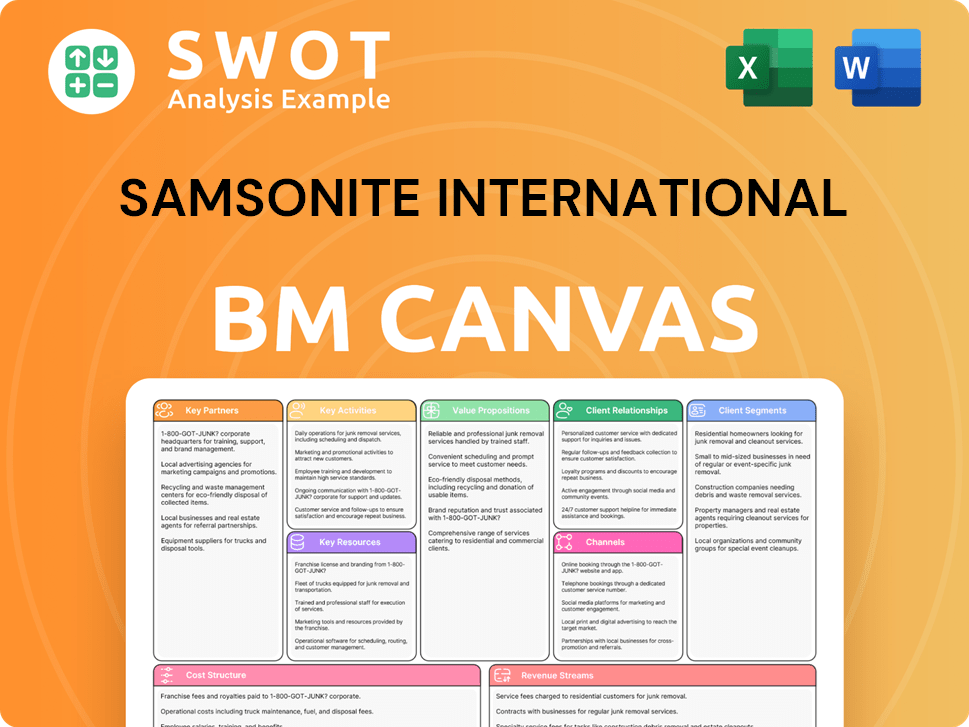
What Risks Could Slow Samsonite International’s Growth?
The path to growth for Samsonite International is not without its challenges. Several risks and obstacles could impact the company's strategic plans and operational performance. Understanding these potential hurdles is crucial for evaluating the company's long-term prospects.
Macroeconomic factors, particularly in the United States, are a significant concern. The U.S. market represents a substantial portion of Samsonite's revenue, making the company sensitive to shifts in consumer spending and overall economic conditions. Trade policies and tariffs, especially those impacting trade with China, also pose a threat.
Competition within the luggage industry adds another layer of complexity. The industry's low barriers to entry and minimal switching costs can intensify competition, potentially affecting profitability. The company is actively managing these risks through cost control measures and a focus on maintaining a strong margin profile. For a deeper dive into how Samsonite operates, you can check out this article: Revenue Streams & Business Model of Samsonite International.
The U.S. market, contributing roughly one-third of Samsonite's revenue, is highly susceptible to economic fluctuations. Consumer sentiment and spending habits directly influence sales. Escalating tariffs and trade policy uncertainties, especially concerning US tariffs on China, could negatively affect sales and profit margins. While diversification of production to Southeast Asia aims to mitigate tariff risks, future exemptions are not guaranteed.
The luggage industry's low barriers to entry and minimal switching costs intensify competition. This could lead to increased competition and pressure on profitability. The premium and luxury sectors, including the Tumi brand, have experienced weaker demand, while American Tourister faces increased competition in India. The luggage industry analysis shows that the operating margins could potentially normalize to pre-pandemic levels of around 14.5% from 16.7% in 2024.
Supply chain vulnerabilities remain an inherent risk for global manufacturers like Samsonite. While not explicitly detailed as recent obstacles, these vulnerabilities can disrupt operations and impact profitability. The company's ability to navigate these challenges will be crucial for maintaining its financial performance.
The company's management is proactive in addressing these risks. Through disciplined expense management and a focus on maintaining a robust margin profile, Samsonite aims to mitigate potential negative impacts. The company's strong record of execution through economic volatility and its agility in managing its business are key to driving long-term growth.
Samsonite International Porter's Five Forces Analysis
- Covers All 5 Competitive Forces in Detail
- Structured for Consultants, Students, and Founders
- 100% Editable in Microsoft Word & Excel
- Instant Digital Download – Use Immediately
- Compatible with Mac & PC – Fully Unlocked
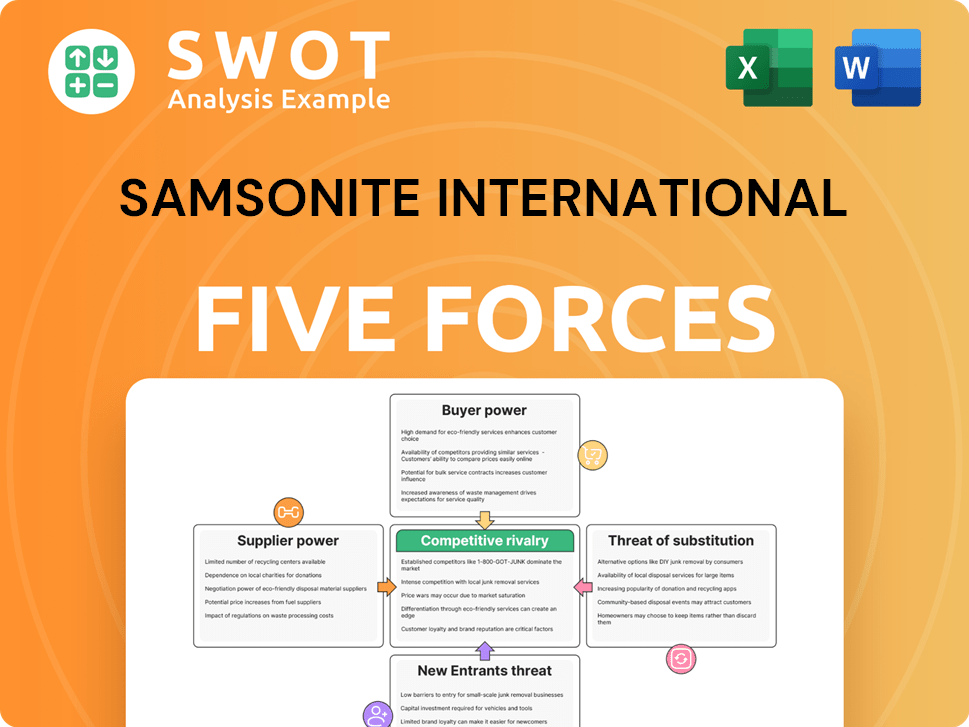
Related Blogs
- What are Mission Vision & Core Values of Samsonite International Company?
- What is Competitive Landscape of Samsonite International Company?
- How Does Samsonite International Company Work?
- What is Sales and Marketing Strategy of Samsonite International Company?
- What is Brief History of Samsonite International Company?
- Who Owns Samsonite International Company?
- What is Customer Demographics and Target Market of Samsonite International Company?
Disclaimer
All information, articles, and product details provided on this website are for general informational and educational purposes only. We do not claim any ownership over, nor do we intend to infringe upon, any trademarks, copyrights, logos, brand names, or other intellectual property mentioned or depicted on this site. Such intellectual property remains the property of its respective owners, and any references here are made solely for identification or informational purposes, without implying any affiliation, endorsement, or partnership.
We make no representations or warranties, express or implied, regarding the accuracy, completeness, or suitability of any content or products presented. Nothing on this website should be construed as legal, tax, investment, financial, medical, or other professional advice. In addition, no part of this site—including articles or product references—constitutes a solicitation, recommendation, endorsement, advertisement, or offer to buy or sell any securities, franchises, or other financial instruments, particularly in jurisdictions where such activity would be unlawful.
All content is of a general nature and may not address the specific circumstances of any individual or entity. It is not a substitute for professional advice or services. Any actions you take based on the information provided here are strictly at your own risk. You accept full responsibility for any decisions or outcomes arising from your use of this website and agree to release us from any liability in connection with your use of, or reliance upon, the content or products found herein.